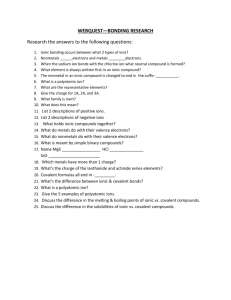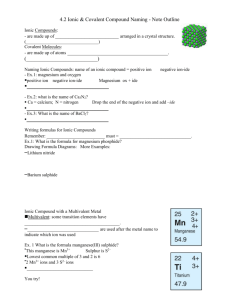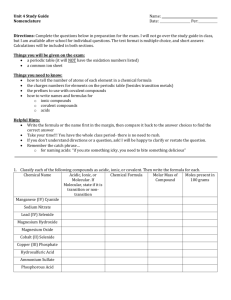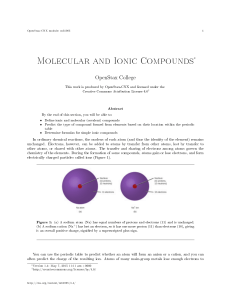test review ws
advertisement
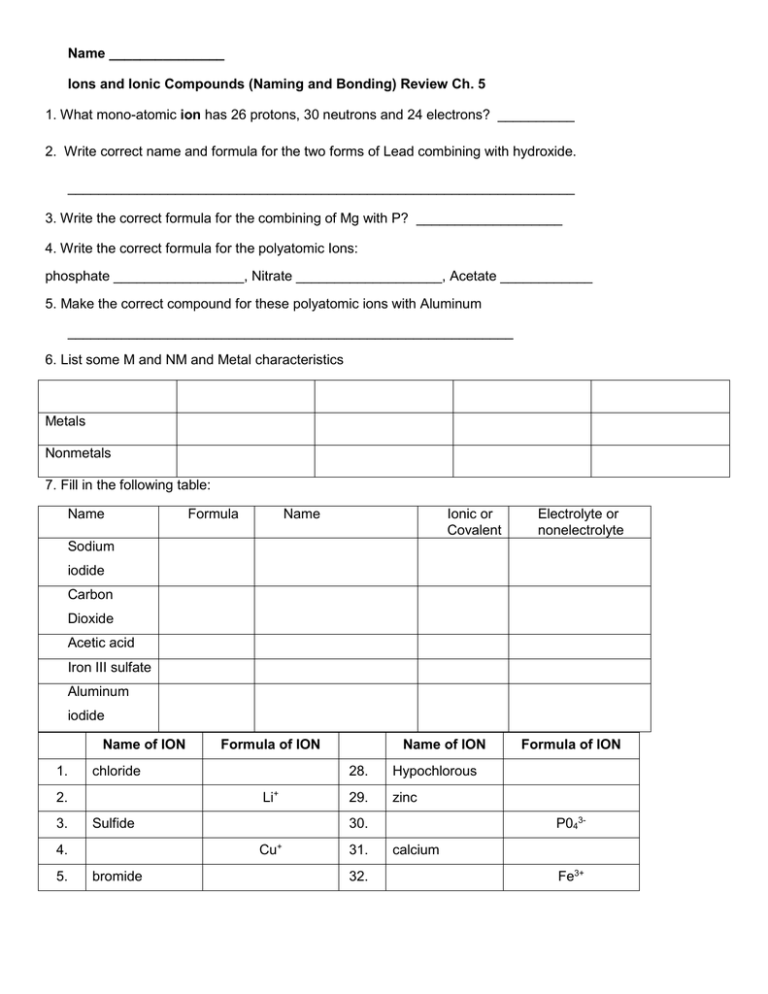
Name _______________ Ions and Ionic Compounds (Naming and Bonding) Review Ch. 5 1. What mono-atomic ion has 26 protons, 30 neutrons and 24 electrons? __________ 2. Write correct name and formula for the two forms of Lead combining with hydroxide. __________________________________________________________________ 3. Write the correct formula for the combining of Mg with P? ___________________ 4. Write the correct formula for the polyatomic Ions: phosphate _________________, Nitrate ___________________, Acetate ____________ 5. Make the correct compound for these polyatomic ions with Aluminum __________________________________________________________ 6. List some M and NM and Metal characteristics Metals Nonmetals 7. Fill in the following table: Name Formula Name Ionic or Covalent Electrolyte or nonelectrolyte Sodium iodide Carbon Dioxide Acetic acid Iron III sulfate Aluminum iodide Name of ION 1. chloride Li+ 2. 3. Sulfide bromide Name of ION 28. Hypochlorous 29. zinc 31. 32. Formula of ION P043- 30. Cu+ 4. 5. Formula of ION calcium Fe3+ Word symbol bank 1. IA- VIIIA 2. Ionic 3. Polar covalent 4. Nonpolar covalent 5. Protons 6. Electrons 7. Neutrons 8. Energy levels 9. Energy gained or lost 10. Ionization energy 11. Electron Affinity (energy) 12. Anion 13. Cation 14. Polyatomic ion 15. Crystal lattice 16. Stable or Octet 17. Low Potential Energy 18. High Potential Energy Sample questions; 1. Element A is a metal that forms a bromide with the formula ABr2. Element A is in the main group ___________________ 2. The formation of a chemical bond involves ________________ 3. When the difference in electronegativity values of elements X and Y increases, the bond type is probably _______________________ 4. A negative ion _________ 5. A positive ion _________ 6. When the atom gains an electron, the resulting particle is _______________ 7. Compounds which as crystals are composed of ions are C) Ionic; A) polar covalent; B) non-polar covalent; D) macro-molecular. 8. Which compound is the most ionic i.e. largest electronegativity difference? A) CCl4(l) B) SiO2(s) C) KCl(s) 9. Consider the general formula A2O3. The elements which form oxides with this formula are in which Group? _________________ 10. Elements A and X combine to form the compound A3X2. If the electron-dot symbol of the neutral atom A shows two electrons, the number of electrons in this symbol for atom X must be ________________________________ 11. Salts or Ionic compounds are arranged in a _______________________________ 12. As independent particles, atoms are ________________________________________ 13. Atoms naturally move toward __________________ 14. How many moles of LiF are present in 60.0 g? ________________________ Nomenclature: 1. Name the compound whose formula is Al2(SO4)3.______________________ 2. Name the compound whose formula is PbI2 ______________________________________ 3. What is the formula for iron (III) oxide? ______________________ 4. What is the formula for silver chloride? _________________________
